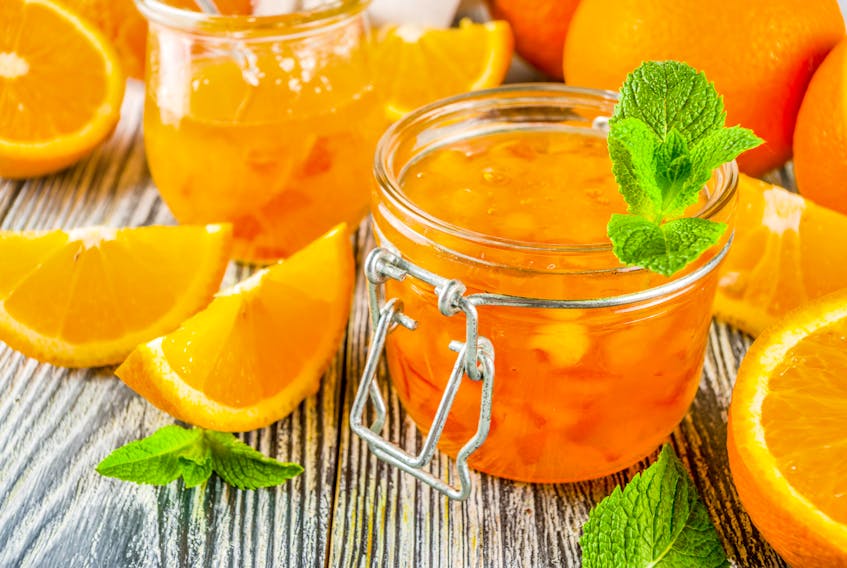
I’d have to be very hungry to eat a raw Seville orange. But marmalade made with those oranges is another story. Spread it on toast, biscuits or crackers and I’m in.
Seville oranges are one of the best-known varieties of bitter oranges. For over 500 years, bitter oranges were the only ones known in Europe, and they were the first to reach the New World, when Spaniards brought them to St. Augustine, Florida.
In “The Flavour Principle” (HarperCollins Publishers Ltd., Toronto, 2013), Lucy Waverman states that we recoil naturally from bitter foods because bitterness can signal that a plant contains a toxin to protect it from predators.
That’s not the end of the story though. People consume all kinds of bitter foods and beverages – marmalade, endive, rapini, beer, coffee, tonic water. Waveman says that with trial and error humans have learned, “to distinguish the truly harmful threats from the false alarms.” I recognize, though, some people (not including me) still avoid coffee, marmalade, and other bitter tastes.
Waverman says “sodium suppresses bitterness.” That explains the popularity of dishes that combine bitter greens such as kale with salty meats such as bacon. I guess it could also be the reason that some folks add a pinch of salt to a glass of beer.
Waverman also states “sugar brings bitterness into balance”. So, generations ago, someone discovered that bitter oranges are not poisonous, and they taste great when cooked with sugar.
There’s a story that in the 1700s, a Scottish grocer James Keiller, from Dundee, bought a cartload of Seville oranges at a cheap price. The oranges were too bitter to eat, so his wife cooked the fruit and rinds into a jam, creating the first commercial marmalade, “Keiller’s Marmelade”.
Being high in both pectin and acid, Seville oranges will make a gel that sets with only the addition of sugar and water. And that sugar works with the bitter flavour of raw Seville oranges to create something delicious.
Seville oranges are available for only a short time every winter, and I often miss them. This year I hit the jackpot, and bought enough to make two batches of marmalade using the following recipe. We’ve been eating it on toast with regularity ever since.
Seville Orange Marmalade
adapted from “The Complete Preserving Book by the Canadian Living Test Kitchen.” Transcontinental Books, Montreal, 2012.
- 8 Seville oranges (1.8 kg/4 lb)
- 2 lemons
- 3.75 l (15 cups) granulated sugar
Scrub oranges and lemons; cut out stem and blossom ends and any blemishes. Cut in half crosswise; squeeze out juice and seeds. Reserving seeds and pulp, strain juice into large Dutch oven.
Pull membranes off peels; tie pulp, seeds and membranes in 20 cm (eight-inch) square of double-thickness cheesecloth to form bag. Add to pan.
Cut orange and lemon halves into thirds. Cut each crosswise into scant 5 mm (quarter inch) thick strips. Add to pan along with any juices.
Add 4 l (16 cups) water, bring to simmer over medium heat. Simmer, stirring often and pressing bag to release pectin, until peel turns to mush when pressed between fingers, two-and-a-half every three hours.
Remove bag, let cool. Squeeze liquid from bag into pan. Measure 3.5 l (15 cups) fruit mixture.
Divide fruit mixture into three batches. For each batch, in clean Dutch oven, bring fruit mixture and 1.25 l (five cups) of the sugar to a full rolling boil over high heat, stirring. Boil hard, stirring constantly, until free of foam, thickened and firmly set, eight minutes. To test for firm set, chill several small plates in the freezer. Drip 2 ml (half a tsp) hot fruit mixture onto one chilled plate; let cool. Return to freezer for one minute. Tilt plate. Mixture should be firm and wrinkle when edge is pushed with finger.
Fill hot 250 ml (one cup) canning jars, leaving 5 mm (quarter inch) headspace. Cover with prepared snap lids. Screw on bands until resistance is met; increase to fingertip tight. Boil in boiling water canner for 10 minutes.
Turn off heat. Uncover and let jars stand in canner for five minutes minutes. Lift rack. With canning tongs, transfer jars to cooling rack; let cool undisturbed for 24 hours.
Makes about 18, 250 ml (one cup) jars.
Margaret Prouse, a home economist, can be reached by email at [email protected].









